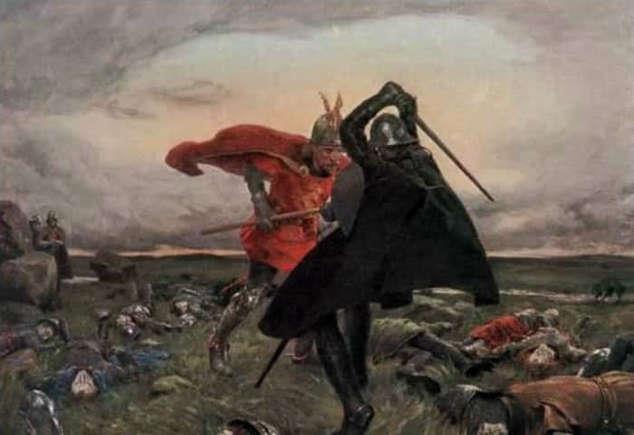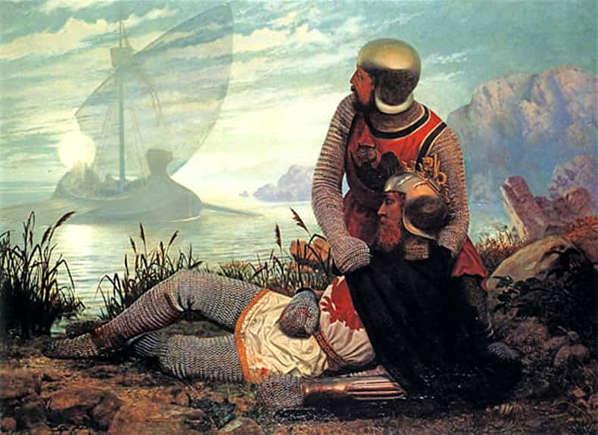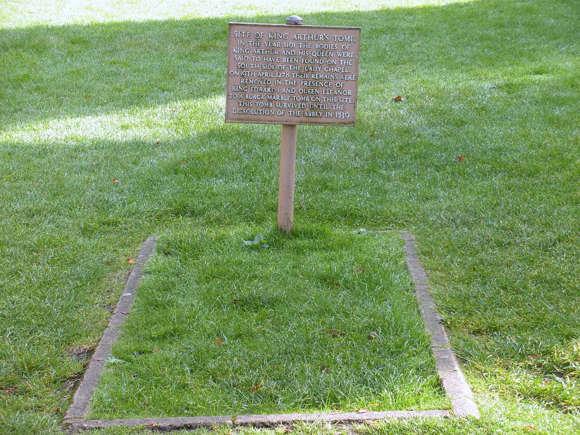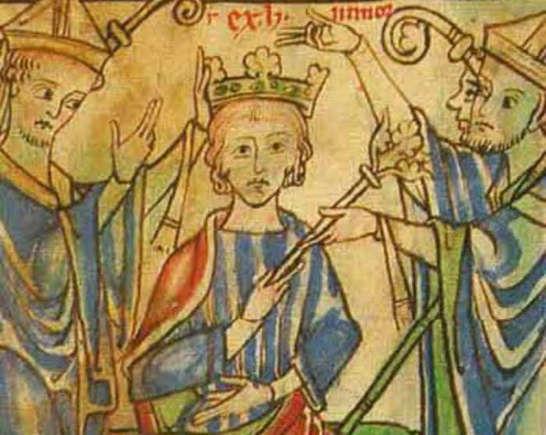




Everything For The Metal Detectorist - King Arthur Origins


King Arthur
Flag of England

Irish Flag
Flag Menu
Union Flag
Copyright All Rights Reserved by Nigel G Wilcox E-Mail: ngwilcox100@gmail.com
The Paragon Of Metal Detecting
& Archaeology
& Archaeology
5. Menu
Pages
Story by Rachel Seigel • .07.24 Factinate Media Group/msn.com [ 05.10.24]
Powered By Sispro1
Designed by Nigel G Wilcox
Member NCMD
The Truth Behind The Legend Of King Arthur
5-5 End

<<< 32. Celtic Water Goddess ©Wikimedia Commons
In Arthurian legend, the Lady of the Lake presents Arthur with the sword Excalibur, and but the myths surrounding her precede Arthur. It’s possible that she was a derivative of the Celtic Water Goeddess Coventina—she is often called "Vi-vianna," which likely comes from "Co-Vianna," a variant of Coventina. The Lady is also referred to as Nimue, which could be a reference to Mnemosyne—one of nine water-nymph muses who gave weapons to Perseus in Greek and Roman mythology.
In Arthurian legend, the Lady of the Lake presents Arthur with the sword Excalibur, and but the myths surrounding her precede Arthur. It’s possible that she was a derivative of the Celtic Water Goeddess Coventina—she is often called "Vi-vianna," which likely comes from "Co-Vianna," a variant of Coventina. The Lady is also referred to as Nimue, which could be a reference to Mnemosyne—one of nine water-nymph muses who gave weapons to Perseus in Greek and Roman mythology.

33. One and the Same ©Wikimedia Commons
According to the stories, King Arthur met his end at the Battle of Camlann, fighting against Mordred, and there is some evidence that this battle (or one similar) actually took place. In the chronicle known as the Annals of Wales, Mordred is noted to be the son of Lot, King of the Picts, which would, in turn, make Mordred himself a Pict. The Picts and the Britons did in fact fight each other in battle once, and that battle was fought by Briton named Artur, son of Aidan. Other records give it different names, but according to David Carroll, author of Arturius: A Quest for Camelot, the Battle of Camlann was based on this actual battle, and he believes this to be strong proof of a historical Arthur.
According to the stories, King Arthur met his end at the Battle of Camlann, fighting against Mordred, and there is some evidence that this battle (or one similar) actually took place. In the chronicle known as the Annals of Wales, Mordred is noted to be the son of Lot, King of the Picts, which would, in turn, make Mordred himself a Pict. The Picts and the Britons did in fact fight each other in battle once, and that battle was fought by Briton named Artur, son of Aidan. Other records give it different names, but according to David Carroll, author of Arturius: A Quest for Camelot, the Battle of Camlann was based on this actual battle, and he believes this to be strong proof of a historical Arthur.
34. Treated Differently
One of the reasons that there's so much murkiness as to whether or not Arthur ever existed is the difference in how history was treated in the Early Middle Ages. Yes, some true events would have been recorded in the period, but many were exaggerations or embellishments, if not absolute fiction, used to suit the motives of the author. In the case of Arthur, whether he existed or not, the different accounts of Arthur’s life are more usefully seen as a reflection on the their time and on whoever wrote them.
One of the reasons that there's so much murkiness as to whether or not Arthur ever existed is the difference in how history was treated in the Early Middle Ages. Yes, some true events would have been recorded in the period, but many were exaggerations or embellishments, if not absolute fiction, used to suit the motives of the author. In the case of Arthur, whether he existed or not, the different accounts of Arthur’s life are more usefully seen as a reflection on the their time and on whoever wrote them.

35. Pre-Middle Ages ©Pikist
Though most of the stories that are told about King Arthur and his knights were transmitted in the Middle Ages, if Arthur truly lived in the fifth or sixth centuries as believed, he lived deep in the era known as the Dark Ages. This was a time when urban life was disappearing and warfare was pretty much constant. Historians named it the Dark Ages because of the arrival of the "barbarian" people into the Western world, but it's now considered to be a derogatory term referring to the fact that knowledge and intellectualism was lost after the Roman era, a statement that is only partly true.
Though most of the stories that are told about King Arthur and his knights were transmitted in the Middle Ages, if Arthur truly lived in the fifth or sixth centuries as believed, he lived deep in the era known as the Dark Ages. This was a time when urban life was disappearing and warfare was pretty much constant. Historians named it the Dark Ages because of the arrival of the "barbarian" people into the Western world, but it's now considered to be a derogatory term referring to the fact that knowledge and intellectualism was lost after the Roman era, a statement that is only partly true.
36. No New Arthurs ©Wikimedia Commons
Considering the importance of King Arthur to English history, it may be surprising to learn that there have been no British kings named Arthur in recorded history. Both Prince Charles and Prince William have Arthur as one of their middle names, but that’s as far as they go. According to Christopher Snyder, dean and professor of history at Mississippi State University and author of The World of King Arthur, the majority of Prince Arthurs have died young, and it's considered a bad omen to outright name a direct heir Arthur.
Considering the importance of King Arthur to English history, it may be surprising to learn that there have been no British kings named Arthur in recorded history. Both Prince Charles and Prince William have Arthur as one of their middle names, but that’s as far as they go. According to Christopher Snyder, dean and professor of history at Mississippi State University and author of The World of King Arthur, the majority of Prince Arthurs have died young, and it's considered a bad omen to outright name a direct heir Arthur.

37. Establishing Ties ©Flickr
In 1233 AD, Richard of Cornwall, the younger brother of King Henry III, traded three of his manors for a small piece of land on the Island of Tintagel. He wanted the land because of the King Arthur’s ties to the area as referenced in Geoffrey of Montmouth’s book. It has long been believed that Richard built a castle there to associate himself with the powerful legend, and maybe it worked? At one point, he was one of the wealthiest men in Europe.
In 1233 AD, Richard of Cornwall, the younger brother of King Henry III, traded three of his manors for a small piece of land on the Island of Tintagel. He wanted the land because of the King Arthur’s ties to the area as referenced in Geoffrey of Montmouth’s book. It has long been believed that Richard built a castle there to associate himself with the powerful legend, and maybe it worked? At one point, he was one of the wealthiest men in Europe.

38. Centurion ©Wikimedia Commons
King Arthur has also been linked to the Roman Centurion named Lucius Artorius Castus, who fought against the Picts, a northern tribe of Scots, in the second century. Castus was a fierce and competent commander, and several sources note the immense number of men he led into battle. This theory is less credible however, as Artorius' battles took place 300 years before Arthur is believed to have existed. Still, it may have been a seed that fed into the myth.
King Arthur has also been linked to the Roman Centurion named Lucius Artorius Castus, who fought against the Picts, a northern tribe of Scots, in the second century. Castus was a fierce and competent commander, and several sources note the immense number of men he led into battle. This theory is less credible however, as Artorius' battles took place 300 years before Arthur is believed to have existed. Still, it may have been a seed that fed into the myth.

39. Here Lies Arthur ©Wikimedia Commons
In 1191 AD, the body of King Arthur was supposedly uncovered by the Monks of Glastonbury Abbey, along with the bones of his wife and a lock of her hair. The man had suffered multiple head wounds, before the final fatal strike. In 1962, Ralegh Radford uncovered the site, showing how the tombs had been disturbed. On display was an ancient lead cross found at the site that was inscribed with the words: "Here lies buried the famous king Arthur with Guinevere his second wife, in the Isle of Avalon". Sadly, today both the cross and the bones have been lost.
In 1191 AD, the body of King Arthur was supposedly uncovered by the Monks of Glastonbury Abbey, along with the bones of his wife and a lock of her hair. The man had suffered multiple head wounds, before the final fatal strike. In 1962, Ralegh Radford uncovered the site, showing how the tombs had been disturbed. On display was an ancient lead cross found at the site that was inscribed with the words: "Here lies buried the famous king Arthur with Guinevere his second wife, in the Isle of Avalon". Sadly, today both the cross and the bones have been lost.

40. Inspired Connection ©Wikimedia Commons
As much as Lancelot himself might be fiction, Dr. Thomas Asbridge of Queen Mary University in London believes that the Lancelot/Arthur friendship was inspired by the friendship that existed between King Henry the Young and his mentor Sir William Marshal. In that story, Marshal allegedly had an affair with Henry’s wife Queen Margaret (whom the King then certainly sent to a far away court), and it could have been transferred to King Arthur’s history. Marshal's possible adulterous affair with Henry's Queen, however, was not his only sin: King Henry's once-loyal companion was also disgraced because of his own arrogance and greed, and he had violently offended his Majesty on several occasions.
As much as Lancelot himself might be fiction, Dr. Thomas Asbridge of Queen Mary University in London believes that the Lancelot/Arthur friendship was inspired by the friendship that existed between King Henry the Young and his mentor Sir William Marshal. In that story, Marshal allegedly had an affair with Henry’s wife Queen Margaret (whom the King then certainly sent to a far away court), and it could have been transferred to King Arthur’s history. Marshal's possible adulterous affair with Henry's Queen, however, was not his only sin: King Henry's once-loyal companion was also disgraced because of his own arrogance and greed, and he had violently offended his Majesty on several occasions.




















